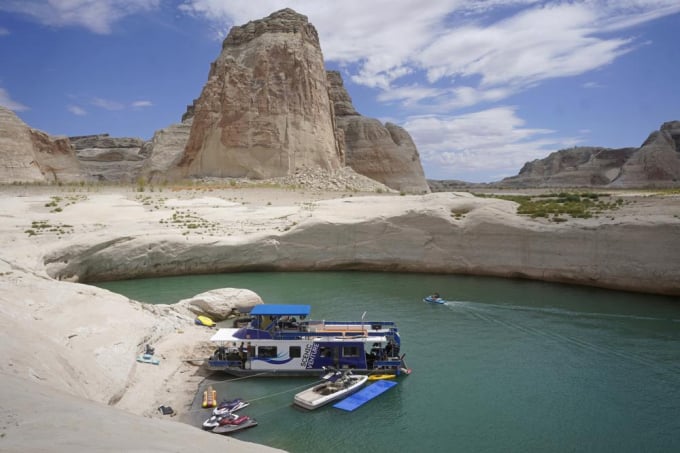May 20, 2025 | 19:05 GMT +7
May 20, 2025 | 19:05 GMT +7
Hotline: 0913.378.918
May 20, 2025 | 19:05 GMT +7
Hotline: 0913.378.918

U.S. hydropower generation is expected to decline 14% this year compared with 2020. Photo: AP
After water levels at a California dam fell to historic lows this summer, the main hydropower plant it feeds was shut down. At the Hoover Dam in Nevada — one of the country’s biggest hydropower generators — production is down by 25%.
If extreme drought persists, federal officials say a dam in Arizona could stop producing electricity in coming years.
Severe drought across the West drained reservoirs this year, slashing hydropower production and further stressing the region’s power grids. And as extreme weather becomes more common with climate change, grid operators are adapting to swings in hydropower generation.
“The challenge is finding the right resource, or mix of resources, that can provide the same energy and power outputs as hydro,” said Lindsay Buckley, a spokesperson for the California Energy Commission.
U.S. hydropower generation is expected to decline 14% this year compared with 2020, according to a recent federal forecast. The projected drops are concentrated in Western states that rely more heavily on hydropower, with California’s production expected to fall by nearly half.
The reductions complicate grid operations since hydropower is a relatively flexible renewable energy source that can be easily turned up or down, experts say, such as in the evenings when the sun goes down and solar energy generation drops.
“Hydro is a big part of the plan for making the whole system work together,” said Severin Borenstein, a renewable energy expert at the University of California, Berkeley and board member of the California Independent System Operator, which manages the state’s electric grid.
Borenstein noted that hydropower is important as the state works to build out its electricity storage options, including by installing batteries that can dispatch energy when it is needed.
Ben Kujala of the Northwest Power and Conservation Council, which handles power planning for the Columbia River basin, also noted that grid operators have adapted how they deploy hydropower in recent years to ensure that it complements solar and wind energy.
Power grids linking Western regions also offer some relief. While California can face multi-year stretches of dry weather, the Pacific Northwest usually gets enough precipitation in the winter to recover and produce hydropower to export.
But this year, the Northwest was also hit by extreme heat and less precipitation, according to Crystal Raymond, a climate change researcher at the University of Washington. While energy planners account for drought years, Raymond said climate change over the long term may further reduce the amounts of melting snow in mountains that fill reservoirs in the spring.
In August, California officials shut down the Edward Hyatt hydropower plant for the first time in its 60-year history after water levels at Lake Oroville sank to historic lows. The plant can produce enough power for up to 750,000 homes, but typically operates at lower levels.
At Lake Powell on the Arizona-Utah border, federal officials recently said there is a 34% chance that the Glen Canyon Dam won’t be able to produce power at some point in 2023, up from a 3% chance for next year, if extreme drought persists.
Declines in hydropower production in California this summer coincided with heat waves, forcing the state to buy extra power. To prevent outages in late September, state officials said they were deploying temporary emergency generators.
“The drought did compound the difficulty of meeting demand,” said Jordan Kern, an energy and water systems expert at North Carolina State University.
In some Northwestern states, hydropower production has reverted closer to normal levels after dipping just below their 10-year ranges earlier this year. California’s hydropower levels remained at the bottom of the state's 10-year range through June. Federal forecasts says much of the West is likely to continue to see drought conditions through the end of the year.
Declines in hydropower production mean production bumps for other energy sources. Natural gas power is expected to rise 7% in California and 6% in the Northwest this year over last, according to federal forecasts. Coal generation is forecast to rise 12% in the Northwest.
The California Air Resources Board says the state has been able to continue reducing the electricity sector’s greenhouse gas emissions despite swings in hydropower generation in recent years.
(AP)

(VAN) Attempts to bring down the price of the Japanese staple have had little effect amid a cost-of-living crisis.

(VAN) Fourth most important food crop in peril as Latin America and Caribbean suffer from slow-onset climate disaster.

(VAN) Shifting market dynamics and the noise around new legislation has propelled Trouw Nutrition’s research around early life nutrition in poultry. Today, it continues to be a key area of research.

(VAN) India is concerned about its food security and the livelihoods of its farmers if more US food imports are allowed.

(VAN) FAO's Director-General emphasises the need to work together to transform agrifood systems.

(VAN) Europe is facing its worst outbreak of foot-and-mouth since the start of the century.

(VAN) The central authorities, in early April, released a 10-year plan for rural vitalization.